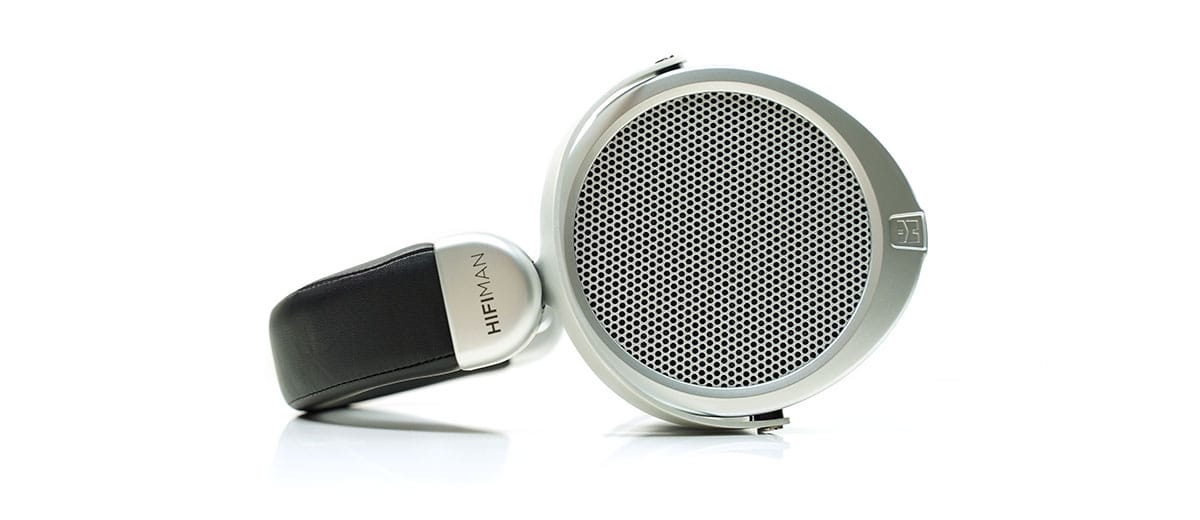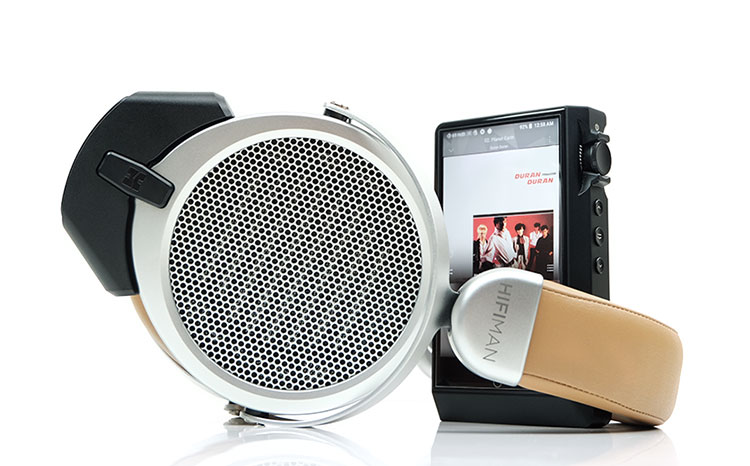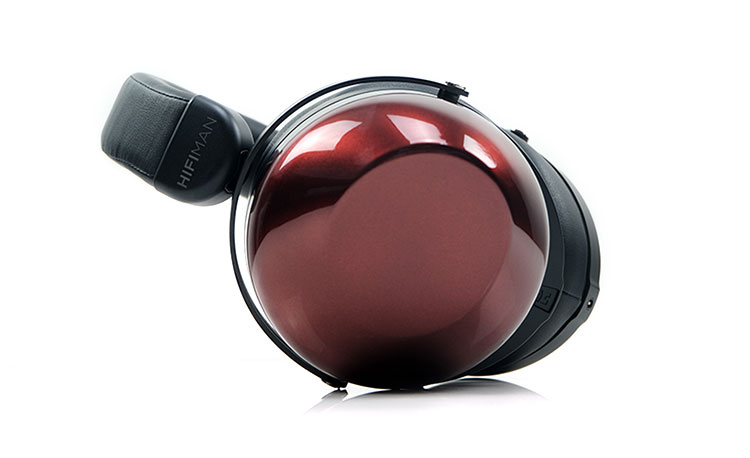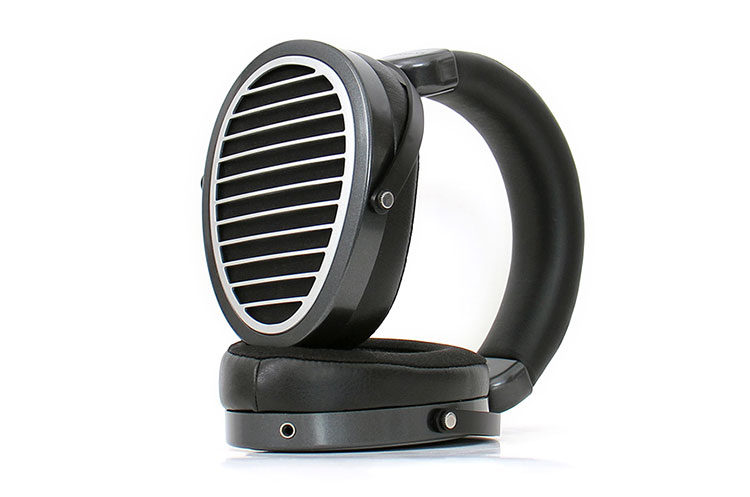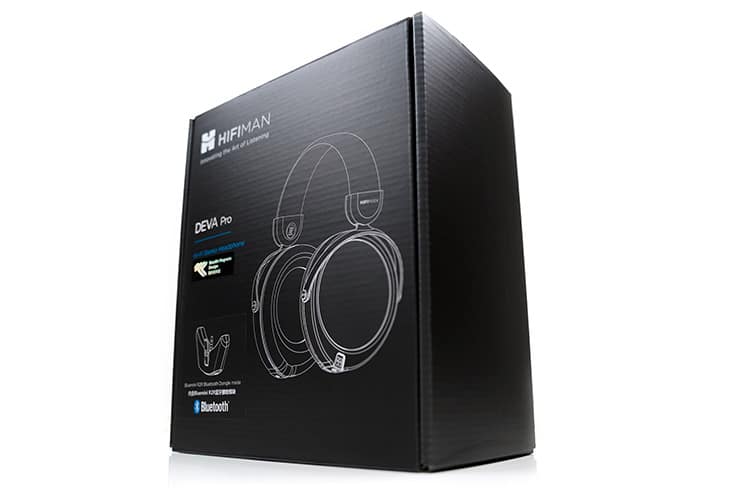Select Comparisons
HIFIMAN Deva
$219
The Deva is the predecessor to the Deva Pro and one of the first of HIFIMAN’s wired/wireless full-sized headphones alongside the Ananda BT. You can find our review of the Deva here.
Technical
These two headphones have a lot of shared characteristics including HIFIMAN NsD or nanotech superthin diaphragm and I dare say probably the same voice coil and trace elements with some tuning tweaks.
In fact, the specifications are an exact match with both having the same 18Ω resistance rating and just over 93dB resistance levels. Both planar headphones will require a decent amp or source for them to sound optimal though the ability to handle the wireless BLUEMINI modules can negate that requirement.
The original Deva did not come with the R2R version of Bluemini but rather the non-R2R Gen 2 version as per our original review. That also means it used the older Qualcomm CSR8675 receiver rather than the newer Qualcomm QCC5124 chipset.
What has changed internally, however, are the magnets with the Deva Pro now using the stealth magnet system in a single-sided array as opposed to the Deva which used HIFIMAN’s previous generation of magnet arrays.
Design
A few cosmetic changes from the old Deva to the new Deva Pro and one significant change regarding the cable entry system. The primary cosmetic change is the color scheme with a new traditional ‘hifi’ color scheme of black and silver replacing the more retro tan and silver.
The form factor has not changed so it’s the exact same circumaural open back or classic HIFIMAN shape with the new thick memory foam single headband. They both weigh the same also with similar pressure displacement on the head so if you enjoyed the first one then the Deva Pro will fit equally well on your head.
The more ‘dramatic’ change is the new dual entry system on the Deva Pro which follows in a similar fashion to the HE-R10 with a dual entry as well as single-entry capability. The older Deva only has a single entry system. You will still need to buy a single 3.5mm terminated single-entry cable to use the system to its fullest extent on the Deva Pro.
Everything else is a mirror of each other including all accessories and packaging save for the switch to the newer and more expensive Bluemini R2R module.
Performance
The FR of both largely follows the same pattern with a flattish low-end, a neutral to slightly forward rise in the mids, and a relatively clean-sounding treble. However, where the Deva Pro steps it up a bit is primarily in the head gain area where vocal and percussion are most prominent.
On the older Deva, the upper mids have more emphasis compared to the Deva Pro. Not by a huge amount but enough to catch a little bit more of a treble overtone in its leading edges of percussion splash and vocal sibilance.
That is compounded by a stronger 8k peak on the original which, in quiet passages, is less obvious but once the upper-mids go up a notch in energy you can hear the upper harmonic order influence a lot more.
With the Deva Pro, the very slight drop in upper mids and 8k peaking amplitude still allows a relatively clean and clear sound but with less unnatural sibilance and a better harmonic balance for percussion timbre.
It also seems the bass response on the Deva Pro has a very minor tweak. This is much more nuanced but around 70-100Hz I can sense a slightly stronger punch and a tighter sound to the Deva Pro bass performance compared to the original. Lower mids also seem slightly more filled-in on the Deva Pro perhaps carrying a marginally better fundamental compared to the original.
Dynamics are subtly more impressive on the Deva Pro but given both are relatively neutral on the low-end, to begin with, the change-up is not huge. Staging height is improved compared to the original sounding a lot busier and more articulate on the Deva Pro compared to the original’s uneven top-end.
HIFIMAN HE-R9
$369
The HE-R9 was launched earlier in 2022 and had been recently reduced in price to make it a competitive option to the Deva Pro. It is also compatible with the Bluemini R2R. You can read our review of the HE-R9 here.
Technical
The HE-R9 is HIFIMAN’s most recent outing and despite the closeness in pricing, they are dramatically different from the Deva Pro.
The only thing really in common is that they are both circumaural headphones, both offer the dual entry/single entry system for cable connections and both use the PeliPad/new headband combo in their builds.
Differences? The HE-R9 is a closed back, the Deva Pro is an open back, the former is a 50mm dynamic driver with a Topology diaphragm, and the latter is a planar magnetic driver surrounded by the company’s new stealth magnet array technology. Very different driver and acoustical space applications with massively different sound signatures.
One thing they do share, however, is the Bluemini R2R compatibility. That means both headphones use a small thin wire to hook up both drivers simultaneously to the Bluemini R2R’s amplifier. With both headphones, you get up to LDAC 24BIT/96k wireless decoding capability.
Rating-wise, the Deva Pro does need more juice at just 93.5dB SPL, despite having a 18Ω resistance marker. The HE-R9 is more efficient and easier to drive at 100dB SPL though, like most dynamic drivers, more impedance dependent at 32Ω.
Design
Aside from those gorgeous deep red shell cups on the HE-R9, the form factor and materials used match the Deva Pro. That means plastic pivot blocks, aluminum frames and gimbals, spring steel headbands, and those thick memory foam pleather-wrapped headbands.
The pads are also virtually the same Pelipad hybrid design though my impression is of a slightly deeper wall on the Deva Pro pads.
The paint job is significantly different also with the HE-R9 a mix of black and polished red and the Deva Pro a more conservative silver and black. Both Bluemini R2R modules are identical in shape and finish.
The HE-R9 is lighter than the Deva Pro which is to be expected given it uses a lighter dynamic driver inside. That combined with a slightly tighter clamp provides for a bit of variation in the wearing experience.
I would say both are very comfortable rather the differences are primarily in the lateral pressure with slightly more clamping power on the HE-R9 and improved passive isolation given its close cup design.
The cables supplied are the exact same 1.5m lightweight black rubber jacket variants with the single copper crystalline wire inside and dual 3.5mm connectors. They will handle the same with low microphonics and memory retention performance.
Performance
Two headphones that are so different that I would class them as complementary to each other and should be side by side depending on your mood rather than compete directly with each other.
There should be no doubting which one is your preferred sound signature here with the voluptuous deep and heavy dynamic driver bass of HE-R9 dominating, followed by a very smooth and even-harmonic biased timbre, neutral to slightly dipped mids and a relaxed treble.
The Deva Pro is definitely more neutral, probably much more audiophile sensible, and clean sounding in its timbral coloration. For those that need a stronger vocal, flatter bass, and livelier treble articulation, it’s the go-to choice between the two.
Since the HE-R9 is a closed cup the staging is much more intimate with that depth complimented by a forwardness that gives it both prominence in the mix as well as a very strong fundamental underpinning lower pitching instruments. It generates a lot of warmth and significantly more bloom in the upper bass than the Deva Pro.
The Deva Pro is far flatter here, but tighter and better defined for my taste. Staging-wise nowhere near the same depth but allows the rest of the FR to breath so it sounds more open, especially through the mids.
The HE-R9 is the more forgiving of the two overall with far less upper order harmonic overtones and generally a more liquid-like tone to its note’s leading edges. However, the Deva Pro has a better balance, stronger midrange clarity, and an airier staging quality from that open-back design.
HIFIMAN Edition XS
$499
The Edition XS was also launched earlier this year and represents the other side of the development house with its classic ovoid-shaped design. You can read our recent review of the Edition XS here.
Technical
Both the Edition XS and the Deva Pro share the same planar magnetic driver heritage and yes, both have received the Stealth Magnet treatment. They also both share the same superthin NsD diaphragm technology but even a casual glance from the outside will tell you these are not the same drivers.
The Edition XS uses an ovoid-shaped planar driver which is a drip-down tech legacy from HIFIMAN’s higher models such as the Ananda and the Arya. I would hazard a guess that there is a larger moving surface area on these types of planar drivers compared to the smaller circular ones used inside the Deva Pro.
However, in terms of sensitivity, there is some similarity here with both rated at 18Ω and the Edition XS just a shade lower at 92dB SPL compared to 93.5dB for the Deva Pro. Both will need a capable amplifier, at least in terms of power, to sound optimal.
One major difference is the lack of Bluemini compatibility on the Edition XS. All but one of the ovoid range of planar headphones from HIFIMAN is not compatible with the BT modules so whilst both will take a similar dual-entry terminated cable, only the Deva Pro has the capability to go wireless.
The one ovoid design that is wireless is the Ananda BT but it’s integrated into the headphone as opposed to detachable.
Design
The Edition XS design and form factor are a complete mix of old and new. It takes the Deva Pro headband and plastic pivot blacks and mixes them in with a more polished piano black version of the classic Ananda ovoid styling or what I loosely call Gen 2 HIFIMAN headphone designs.
Both look very different in that regard, but, despite the Edition XS being heavier by 45g I actually find it the more comfortable of the two headphones courtesy of the much wider internal oval opening on the hybrid pads.
You might find though that vertical pressure is slightly more than lateral on the Edition XS, however. That is fairly normal for this style of HIFIMAN headphones. The Deva Pro does have the slightly better vertical to lateral pressure balance but the pad opening is smaller and tends to brush my ear a bit more as a result.
Both headphones come with the exact same 1.5mm rubbery jacketed single crystalline wire cables which seems to be a feature at this price point. The higher-end HIFIMAN models have some other variations including balanced XLR and nylon jacketed 6.35mm plugs as is the case with the Arya Stealth.
Performance
You have to split these two between timbre and technical capability because with the former there might be some preferences at play here but with the latter, the Edition XS is clearly the superior performer.
The Deva Pro does not offer the same holographic staging quality as the Edition XS. It sounds relatively flat throughout the bass whereas the Edition XS has more of a sub-70Hz bump giving it a more planted and deeper sound quality.
Mid clarity is also a step up on the Edition XS, not just in resolution but also in speed and articulation with improved instrumental separation to go along with it. With the Deva Pro, it sounds more compressed in the middle, still relatively clear but lacking that same deep spatial arrangement.
A familiar pattern for the treble with again, the Edition XS stretching up that bit more bringing out a bit more air and improving on the presentation expansiveness. In HiFi terms, it feels like you switched from good bookshelf speakers to tower speakers.
Now timbral coloration is more of a toss-up. I actually like the slightly softer upper mids and treble coloration of the Deva Pro. The Edition XS has more contrast and more head gain giving it a spicier mids and treble coloration that can be more exciting but slightly less forgiving.
The Edition XS also has a more neutral lower-mids with enhanced bass to mids separation whereas the Deva Pro carries a little more warmth in its more elevated upper-bass to lower-mids transition.
Overall, the Edition XS is definitely a step up in technical capability, sounding bigger, quicker, and more resolving whereas the Deva Pro is perhaps the more forgiving of the two.
Our Verdict
Overall, the HIFIMAN Deva Pro remains a good value proposition for entry-level planar headphones with the flexibility of real strong wireless performance.
It takes the relatively mid-centric but slightly uneven original tuning and refines the highs a bit, smooths out the mids, and introduces a bit of a tighter bass punch. The materials choices for the design are untouched save for and more conservative paint job.
The Bluemini R2R is a cracking little BT module. It teases out a little more of that classic natural R2R tone with a stronger vocal focus but without giving up too much in the way of dynamic range.
Do pair these with a reasonably dynamic source or desktop amp to get the best out of them if going wired. They do not cost a huge amount but if you want to hear them properly then like most planar driver headphones, they sound at their best with decent power.
HIFIMAN Deva Pro Specifications
- Driver Type: Planar Magnetic Driver with Stealth Magnet Design
- Frequency Response : 20-20kHz
- Impedance: 18Ω
- Sensitivity: 93.5dB
- Weight: 360g
- Socket: TRRS 3.5mm Balanced Socket
Bluemini R2R Specification
- DAC: HiFiMAN Himalaya
- DAC Architecture: R2R
- Frequency Response : 20Hz-20kHz
- TDH: 0.022%
- SNR: -114dB
- Battery Life: about 8 Hours
- Weight: 25g
- Bluetooth Codecs: LDAC, aptX-HD, aptX, AAC, SBC
- Transmission: Bluetooth/USB Type C

